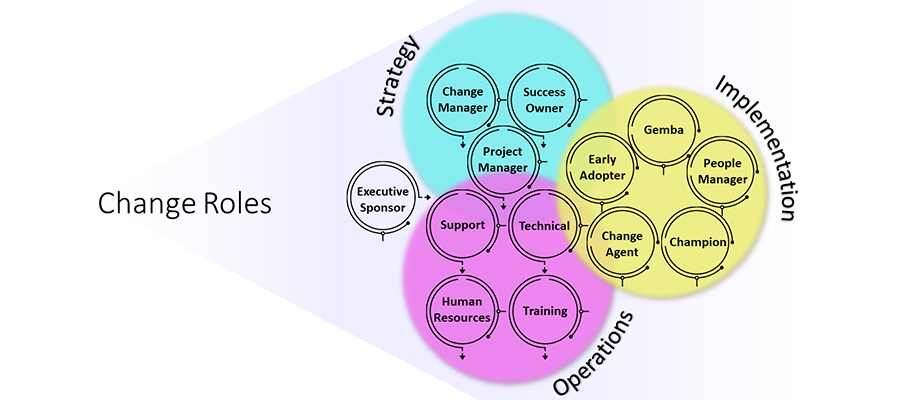
Who do you need on your change team? Getting the right people on board with a project is a critical aspect of success, so let’s look at the roles that you need to make your change project successful – and how those roles interact. While each change initiative is different, there are patterns we can identify that are useful for getting the best results.
It Starts with One
While it’s possible to start a project differently, most of the time, major changes are initiated by an executive sponsor. In this context, “executive” may not mean literally executive in the organization; it conveys that they’re willing to use their influence to kick off and support the change initiative. The sponsor may have dreamed up the change themselves or, more likely, were a part of a group that decided on a direction, and they agreed to shepherd it.
Occasionally, projects start without sufficient support from a sponsor, because they don’t have the power, legitimacy, or urgency necessary to get the change accomplished. In these conditions, it may be necessary to recruit other sponsors by reviewing stakeholder salience and building a coalition of sponsors with the qualities necessary to achieve success.
Strategy Team
The executive sponsor typically engages three key additional roles to get things going:
- Success Owner – This individual will be the day-to-day contact on the team accountable for results. Sometimes the sponsor will play this role themselves, and other times they’ll delegate it to someone else they trust.
- Change Manager – The change manager has the skills necessary to coordinate activities for success when human behavior change is required – as it is in most change initiatives. Occasionally, for smaller or less risky projects, a sponsor may engage with a change agent rather than a change manager.
- Project Manager – Project management is responsible for planning execution against the agreed upon steps. Project managers track tasks, risks, issues, and plans.
The strategy team will, in turn, reach out to an operations team to obtain the skills they need to operationalize the change in the organization.
Operations Team
The operations team are typically non-dedicated resources who support the operations of the organization. They bring technical skills, organizational knowledge, and capabilities to ensure that the change is successful. The roles for the operations team are:
- Technical – These resources are responsible for any specific technical changes required to make the change work.
- Support – These resources are responsible for supporting operations when things go wrong and often provide validation about how things are – or are not – working well.
- Training – Training resources are engaged to create greater clarity about the behaviors and skills that are desired and to create training packages that lead to those outcomes.
- Human Resources – As human behavior changes are involved and communications are needed, human resources will often be an essential part of the operations team.
While the operations team can enable and support the change, they’re not typically the ones who must change their own behaviors. The strategy team and the operations team often jointly engage with the implementation team.
The Implementation Team
The implementation team includes everyone whose behavior or expectations must change. They are identified in five key roles that are engaged to help ensure the success of the project.
- Change Agent – This role is a “mini” change manager who helps to coordinate and encourage the right behaviors. These may be pulled from a central team or engaged with the business to support the change.
- Gemba – The gemba is the person who really does the work. These powerful allies can ground you in reality and ensure that the plans for change can work.
- Early Adopter – The early adopters are those risk takers in the organization who are willing to be different and get things started. They’re often not the people who can support and encourage others directly, but their experience with the change will be closely watched by others.
- Champion – Often confused with early adopters, champions are cheerleaders for the change. They provide a conduit between the users at large and the change team to ensure that their voices are heard and, conversely, that everyone understands the change.
- People Manager – People managers can either support or block changes. People managers are an important part of the implementation team and often activated by human resources as part of their regular professional development and support.
Obviously, the roles are filled by many people as they make the changes envisioned into a reality.
Structure
Historically, organizations and projects would have a strict organizational hierarchy and lines of authority. However, the rapid rate of change has caused organizations to focus on key responsibilities and activities with the understanding that formal lines of authority will be fluid. Rather than being responsible to one person, teams are often responsible for creating conditions for success based primarily on their ability to work together and only relying on formal authorities and responsibilities when there are no other options.
Change initiatives in particular often feel more like living organisms than concrete structures. The change manager, project manager, and success owner frequently shift tasks and activities so that they’re collectively able to accomplish the best for the change initiative. The strategy and operations teams are the most effective when they’re willing to work in a world of adaptation rather than rigid rules.
Even the implementation team involves people who are often not required to do the work but are instead excited to work with others and are willing to stray outside their formal responsibilities to ensure the success of the initiative.
